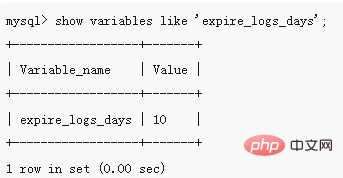How to delete binary log in mysql
3 methods: 1. Delete all logs with the syntax "RESET MASTER;". After deletion, new binary logs will be created again; 2. Delete logs according to the number with the syntax "PURGE MASTER LOGS TO ' file name.number';", all binary logs with numbers less than the specified "number'" will be deleted; 3. Delete logs based on the creation time, the syntax is "PURGE MASTER LOGS TO 'yyyy-mm-dd hh:MM:ss';".

The operating environment of this tutorial: windows7 system, mysql8 version, Dell G3 computer.
Mysql method of deleting binary logs
After the binary log is started, a new binary log file will be generated every time the MySQL service is restarted. .
The binary log records a large amount of information. If the binary log is not cleaned for a long time, a lot of disk space will be wasted. There are many ways to delete binary logs. Here are several ways to delete binary logs.
Method 1: Delete all binary logs
Use the RESET MASTER statement to delete all binary logs. The form of the statement is as follows:
RESET MASTER;
Log in After opening the MySQL database, you can execute this statement to delete all binary logs. After all binary logs are deleted, MySQL will re-create new binary logs with numbers starting from 000001.
Method 2: Delete binary logs based on number
Each binary log file is followed by a 6-digit number, such as 000001. Logs up to the specified binary log number can be deleted using the PURGE MASTER LOGS TO statement. The basic syntax form of this statement is as follows:
PURGE MASTER LOGS TO 'filename.number';
This statement will delete all binary logs with numbers less than filename.number.
Example:
//删除bin-log.000002之前的二进制日志 purge binary logs to 'bin-log.000002';

Method 3: Delete binary logs based on creation time
Use PURGE The MASTER LOGS TO statement can delete binary logs created before the specified time. The basic syntax format of this statement is as follows:
PURGE MASTER LOGS TO 'yyyy-mm-dd hh:MM:ss';
where "hh" is the 24-hour hour. This statement will delete all binary logs created before the specified time.
Example: Delete the binary log created before 2019-12-20 15:00:00
PURGE MASTER LOGS TO '2019-12-20 15:00:00";
After the code is executed, all the binary logs created before 2019-12-20 15:00:00 Binary logs will be deleted.

In addition, we can also set the expire_logs_days parameter to set automatic cleanup. Its default value is 0, which means that the expired automatic deletion function is not enabled.
show variables like 'expire_logs_days';

If the automatic cleaning function is enabled, binary log files that exceed this number of days will be automatically deleted. Automatic deletion usually occurs when MySQL starts or when FLUSH logs are flushed.

[Related recommendations: mysql video tutorial]
The above is the detailed content of How to delete binary log in mysql. For more information, please follow other related articles on the PHP Chinese website!

Hot AI Tools

Undresser.AI Undress
AI-powered app for creating realistic nude photos

AI Clothes Remover
Online AI tool for removing clothes from photos.

Undress AI Tool
Undress images for free

Clothoff.io
AI clothes remover

AI Hentai Generator
Generate AI Hentai for free.

Hot Article

Hot Tools

Notepad++7.3.1
Easy-to-use and free code editor

SublimeText3 Chinese version
Chinese version, very easy to use

Zend Studio 13.0.1
Powerful PHP integrated development environment

Dreamweaver CS6
Visual web development tools

SublimeText3 Mac version
God-level code editing software (SublimeText3)

Hot Topics
 1378
1378
 52
52
 MySQL: The Ease of Data Management for Beginners
Apr 09, 2025 am 12:07 AM
MySQL: The Ease of Data Management for Beginners
Apr 09, 2025 am 12:07 AM
MySQL is suitable for beginners because it is simple to install, powerful and easy to manage data. 1. Simple installation and configuration, suitable for a variety of operating systems. 2. Support basic operations such as creating databases and tables, inserting, querying, updating and deleting data. 3. Provide advanced functions such as JOIN operations and subqueries. 4. Performance can be improved through indexing, query optimization and table partitioning. 5. Support backup, recovery and security measures to ensure data security and consistency.
 MySQL: Simple Concepts for Easy Learning
Apr 10, 2025 am 09:29 AM
MySQL: Simple Concepts for Easy Learning
Apr 10, 2025 am 09:29 AM
MySQL is an open source relational database management system. 1) Create database and tables: Use the CREATEDATABASE and CREATETABLE commands. 2) Basic operations: INSERT, UPDATE, DELETE and SELECT. 3) Advanced operations: JOIN, subquery and transaction processing. 4) Debugging skills: Check syntax, data type and permissions. 5) Optimization suggestions: Use indexes, avoid SELECT* and use transactions.
 How to open phpmyadmin
Apr 10, 2025 pm 10:51 PM
How to open phpmyadmin
Apr 10, 2025 pm 10:51 PM
You can open phpMyAdmin through the following steps: 1. Log in to the website control panel; 2. Find and click the phpMyAdmin icon; 3. Enter MySQL credentials; 4. Click "Login".
 How to create navicat premium
Apr 09, 2025 am 07:09 AM
How to create navicat premium
Apr 09, 2025 am 07:09 AM
Create a database using Navicat Premium: Connect to the database server and enter the connection parameters. Right-click on the server and select Create Database. Enter the name of the new database and the specified character set and collation. Connect to the new database and create the table in the Object Browser. Right-click on the table and select Insert Data to insert the data.
 MySQL and SQL: Essential Skills for Developers
Apr 10, 2025 am 09:30 AM
MySQL and SQL: Essential Skills for Developers
Apr 10, 2025 am 09:30 AM
MySQL and SQL are essential skills for developers. 1.MySQL is an open source relational database management system, and SQL is the standard language used to manage and operate databases. 2.MySQL supports multiple storage engines through efficient data storage and retrieval functions, and SQL completes complex data operations through simple statements. 3. Examples of usage include basic queries and advanced queries, such as filtering and sorting by condition. 4. Common errors include syntax errors and performance issues, which can be optimized by checking SQL statements and using EXPLAIN commands. 5. Performance optimization techniques include using indexes, avoiding full table scanning, optimizing JOIN operations and improving code readability.
 How to create a new connection to mysql in navicat
Apr 09, 2025 am 07:21 AM
How to create a new connection to mysql in navicat
Apr 09, 2025 am 07:21 AM
You can create a new MySQL connection in Navicat by following the steps: Open the application and select New Connection (Ctrl N). Select "MySQL" as the connection type. Enter the hostname/IP address, port, username, and password. (Optional) Configure advanced options. Save the connection and enter the connection name.
 How to recover data after SQL deletes rows
Apr 09, 2025 pm 12:21 PM
How to recover data after SQL deletes rows
Apr 09, 2025 pm 12:21 PM
Recovering deleted rows directly from the database is usually impossible unless there is a backup or transaction rollback mechanism. Key point: Transaction rollback: Execute ROLLBACK before the transaction is committed to recover data. Backup: Regular backup of the database can be used to quickly restore data. Database snapshot: You can create a read-only copy of the database and restore the data after the data is deleted accidentally. Use DELETE statement with caution: Check the conditions carefully to avoid accidentally deleting data. Use the WHERE clause: explicitly specify the data to be deleted. Use the test environment: Test before performing a DELETE operation.
 How to use single threaded redis
Apr 10, 2025 pm 07:12 PM
How to use single threaded redis
Apr 10, 2025 pm 07:12 PM
Redis uses a single threaded architecture to provide high performance, simplicity, and consistency. It utilizes I/O multiplexing, event loops, non-blocking I/O, and shared memory to improve concurrency, but with limitations of concurrency limitations, single point of failure, and unsuitable for write-intensive workloads.




